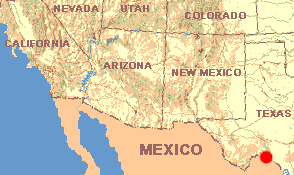 February 3, 1988
February 3, 1988TEXAS: Valverde County
US 377 North Campground in Amistad National Recreation Area 7 miles north of Del Rio
 February 3, 1988
February 3, 1988This chaparral -- this horizon-to-horizon ocean of dry, chest-high Cenizo with occasional emergent yucca and agave -- is the scene of a population explosion of Black-tailed Jackrabbit, Eastern Cottontail and White-tail Deer. On a typical five-mile morning walk, five or more deer are spooked from hiding places along the trail. They bound away blowing snorts and flashing white rump patches, warning other deer that I'm coming. Maybe a dozen jackrabbits and as many cottontails also are spotted, leaping and dodging, struggling mightily to escape, as if my very eyes were red-tailed hawks swooping down for the kill.
In places, not a single cenizo bush remains not severely damaged by these animals' bark-gnawings and branch-tip croppings. Many large stem bases are completely girdled. Rabbit tooth-marks are plainly chiseled in the debarked wood. Later in spring these girdled stems will die. The gnawed areas show up as bright, straw-colored splotches on the cenizo's dark-gray stems.
The most conspicuous sign of this awful excess of rabbit and deer consists of the droppings these animals leave behind. In places their excreta lies as thick as chicken manure in a farmer's pen. Both jackrabbits and cottontails leave dry, spherical, pellet-like scats ("scats" is a general term for animal droppings) that look like marble-sized, dried-out balls of varnished, yellow sawdust. The handlens shows this "sawdust" to be clippings of grass stems and leaves that are in such an undigested state that it's hard to see how the animals could have derived much nutrition from them. The only difference I find between jackrabbit and cottontail pellets is that the jackrabbits' are slightly larger, averaging about half an inch in diameter, while the cottontails' are only about 3/8 of an inch.
Deer scats found here also are pellet-like, averaging about 5/8 of an inch long. The ones I'm seeing are not spherical, but rather oblong, often bearing "nipples" on one or both ends, and though they're composed of straw-like clippings like the rabbits', they're darker in color. Olaus Murie in his Peterson Field Guide entitled A Field Guide to Animal Tracks points out that animal droppings vary in size, texture, form and color, depending on the food that's been eaten, and thus on the season. For instance, a plant-eater's dry winter food might produce hard, compact pellets, but the same animal's excreta developed from moist summer food may be deposited in a rather less compact state. In fact, Murie's book includes an entire page of drawings portraying eight different varieties of white-tail deer droppings.
On the dirt road leading through the chaparral between camp and the US 377 bridge, appearing nearly every morning are fresh deposits of long, greenish-black scats composed mostly of hair, feathers and bone. The beginner might guess that these mystery scats were being left by armadillos, simply because the size seems right and armadillos are common here. But then Murie reminded me that when armadillos root in the ground looking for their fare of insects and grubs they swallow plenty of dirt. Naturally this dirt causes their scats to be thick, chunky, gritty affairs with rounded ends, very unlike the slender objects being found on the bridge road. Moreover, armadillo scats wouldn't contain bone and hair.
After rejecting armadillos, for a moment I wondered whether I might be finding skunk scats, for around here we have spotted, striped, hognose and possibly hooded skunks. However, Murie's skunk scats also lack long-drawn ends.
So, mostly because of the scats' shape, composition and size, I settle on the dog family. Coyote and wolf scats are larger than the ones being found. That leaves foxes. Burt and Grossenheider's A Field Guide to the Mammals places Amistad Reservoir within the distribution areas of the kitfox, red fox and gray fox. One of the campers here claims that early one morning he saw a kit fox in the bridge area, so maybe that's our scat-leaver.